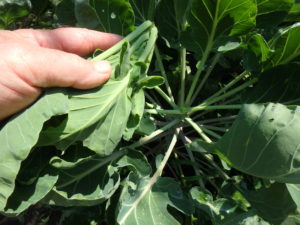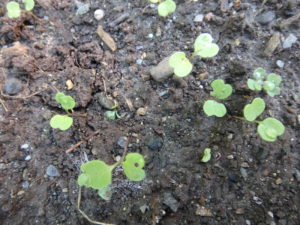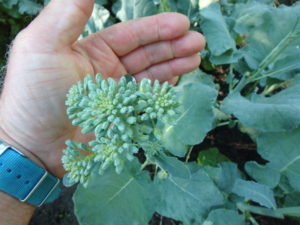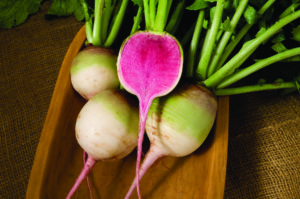Tips for Squeezing Out a Little More Food from Your Vegetable Garden
Want to maximize the output of your garden? Now is the time to act. Here are a few things you can do that will help.
Brussels sprouts: Have you had trouble getting full-sized sprouts? These plants need to be topped in the fall to get the tiny sprouts to develop into full-sized ones. I do it each year on Labor Day, but you can do it now. Cutting off the top cluster of leaves means that the plants will no longer continue getting taller, and put all energy into beefing up those tiny cabbage-like sprouts to their full potential.
Brussels sprouts are very tough when it comes to frost – they will survive cold weather and snow without blinking. I’ve been known to wait until December to pick my sprouts, or to finish harvesting them. But be forewarned: deer love Brussels sprouts in the winter.
Swiss chard: Both Swiss chard and beets are in the species Beta vulgaris. Hundreds of years ago some plants were selected for their tasty roots, others for their leaves. But you can eat the roots of Swiss chard just as you do beets, and the flavor is almost identical. I like red-leafed Swiss chard roots the best. They are smaller, but sweet and tender – and a free dish you weren’t expecting when you planted them. Be sure to peel Swiss chard roots as they have fine roots that feel a little fuzzy if you don’t.
Tomatoes: Right now I have more tomatoes than I can eat fresh, and don’t have time to make sauce. What to do? I freeze whole tomatoes raw, un-blanched. I just place whole tomatoes in zipper freezer bags. In winter when making a soup or stew I remove them from the freezer, run them under hot water in the sink. That loosens the skin, which I rub off. Moments later I chop the tomatoes and use for cooking.
Kale: In case you forgot to plant some, or the deer ate yours, there are alternatives. You can eat the leaves of any crucifer-family veggie (broccoli, cauliflower, cabbage, kale, bok choy, arugula, Brussels sprouts, collards, watercress and radishes). Pick newer leaves, as the older leaves may be tough. I recently used some Brussels sprouts tops in a smoothie, and they were fine!
Asparagus: Yes, I know the harvest is long over. But this is the time to maximize next year’s harvest. Weed your bed, rake off any mulch, and add an inch of good compost and some organic fertilizer. At the same time, pull out any new asparagus seedlings that have started from the little red “berries”, as they will compete with the mature plants.
Actually, modern breeding techniques have made better varieties available. Anything with “Jersey” in the name is all male, and will not produce berries that produce seedlings. Wait to cut back the fronds until they turn brown – green foliage is still feeding the roots.
Pumpkins and squash: Some vines will continue to grow until frost, but now is the time to rein them in. Cut back growing tips and let the existing vines feed your winter squash or pumpkins, and don’t let new blossoms remain on the vines. It’s too late for all but some fast-growing summer squash to produce food from blossoms appearing now.
Be sure to pick or cover your vine crops on nights when the temperature approaches 32. Last year I picked some small un-ripe pumpkins on a late afternoon when frost was forecast, and they ripened on my steps to a full orange. I brought them into the mudroom when frost was forecast, and by Halloween I had quite a nice display of orange fruits.
Cabbage: Instead of pulling your plants now, cut off the cabbages to harvest. Then cut an X into the stem. It’s a little late for this, but you might still get some small cabbages ranging in size from golf ball to softball. I have gotten 4 little cabbages from each stem by doing this.
Chives: This is the time to dig some up and leave outside in plastic pots (which won’t be damaged when they freeze). You can then bring them in, one at a time, and when they thaw, the leaves will be fresh and tasty. When finished harvesting, just put them outside until spring and re-plant. They will be no worse for wear.
Rosemary: Another good herb for winter use. I grow mine I pots and bring them in and grow on a sunny south or west-facing window. If you have some in your garden, pot it up now. But don’t bring it inside. Let it get used to being in a pot right where it has been growing.
Rosemary is hardy to about 25 degrees, and a little frost will help minimize problems with aphids when you bring it in. Do not fertilize when you pot it up, but do shake off some of the soil and pot it in potting mix to improve drainage. Don’t overwater, but never let potted rosemary dry out completely – it will die.
If you have some tips for squeezing out a little extra food from the garden, please send them to me either at P.O. Box 364, Cornish Flat, NH 03746 or at henry.homeyer@comcast.net. Thanks! And contact me if you are interested in going on a Viking River Cruise with me next June from Paris to Normandy and back, with a stop at Monet’s garden in Giverny.
Veggies You Can Plant Now for Fall Eating
Most gardeners don’t think of July as the time to plant seeds in the vegetable garden. But it should be. This is a good time to plant many things including broccoli, Happy Rich, lettuce, kohlrabi, fall radishes, carrots and beets. With good warmth and plenty or rain (or water from your hose), these plants will probably do better now than in if they were planted in the spring.
If you planted peas, spinach or lettuce early this spring, you probably have a bed that is empty now. Instead of just growing weeds, why not get out your seed packets and plant a second crop in that bed?
In the spring I generally plant seeds in those little black plastic 6-packs. I do that because the soil outdoors is cold and wet, and seeds are prone to rot. Now, however, the soil is warm and seeds will germinate much more quickly. All you have to do is check them daily to be sure that the soil has not dried out.
Broccoli, if you read the seed package, takes about 55 days to maturity. So if you plant in mid-July, you should be picking heads of broccoli in mid-September or even a bit earlier. Read the seed packets carefully: as I peruse my Johnny’s Selected Seeds catalog, I see broccoli varieties that mature in anywhere from 48 to 80 days. Some varieties like ‘Arcadia’ (63 days) are listed as “Tolerant of cold stress.” That one also says it makes lots of side shoots. Since broccoli produces well into October for me, getting side shoots is important.
So how should you plant broccoli if you have always put it in as nice little plants that you – or the local grower down the road – has grown? I would suggest planting 3 seeds in groups about 16 inches apart. Why 3 seeds? First, not every seed will germinate, so I like to ensure that at least one will come up. But rather than plant them like carrots in a long line, just plant a few seeds where you want one plant. Then as soon as the plants have 2 real leaves, pull out all but one. And since you’ll see leaves in clumps every 16 inches, you won’t have a hard time identifying them – even if you have never done it before.
One of my favorite veggies is one you might not know: Happy Rich. It is a non-heading broccoli type plant. Instead of one big head, it produces many small heads similar to side-shoots on standard broccoli. I get seeds from Johnny’s Seeds. A similar plant is piricicaba, which I get from Hudson Valley Seed Library. Both are quick to mature and have sweet flavored florets. I find they are tasty even if the florets don’t get picked on time and they produce white or yellow flowers. And the leaves are tasty, too!
Carrots and beets can take 55 days to maturity, or up to 80 days. Select early varieties for fall crops now. Yaya and Mokum are both under 60 days, while most storage carrots are about 75 days – which still means they will be ready by the end of September – and long before hard frost.
I suggest buying pelleted seeds for carrots if planting now. Pelleted seeds are coated with a layer of clay, which means they are much larger and easier to handle. Plant them an inch or two apart and they will not be competing with each other as tiny seedlings – and will grow faster. Planted an inch apart you will not have to thin them until they are edible-sized.
I planted lettuce and arugula seeds in late June. Arugula, which is basically a weed, germinated right away. Both need little or no soil cover – they need light to germinate. I try to plant lettuce once a month all summer and into the fall to keep it coming. Hot weather encourages lettuce to bolt, or produce flowers and seeds. Once the plants start to elongate in preparation for flowering, they get a bit bitter. Edible, but not as sweet.
Swiss chard is another quick and easy crop that you can plant now. My High Mowing organic seed catalog has half a dozen different varieties that mature in 50 to 60 days, and produce baby greens in 25. I particularly like the ‘Rainbow Mix’ that has stems of yellow, red and orange. And did you know that beets and Swiss chards are just variations on the same species? Yup. And you can eat the roots of Swiss chard like beets when you pull them in the fall.
My favorite radish is one that I will plant soon: ‘Red Meat’ radish from Johnny’s seeds. It is red in the middle instead of white like a watermelon. It never has the sharp bite of a spring radish, and stays nice even when the radishes get to be golf ball-sized and bigger. If planted in spring, it bolts.
In the past I’ve had good luck planting daikon radishes in the summer for fall use, too. These Japanese radishes get huge, and have a distinctive bite. Many use them for pickling.
So get out there and plant some seeds. Just be sure that they stay well-watered and most things will do just fine. Even many green beans only need 55 days. So if you were too busy to plant before the 4th of July, get started now.
Read Henry’s twice-weekly blog posts at https://dailyuv.com/








